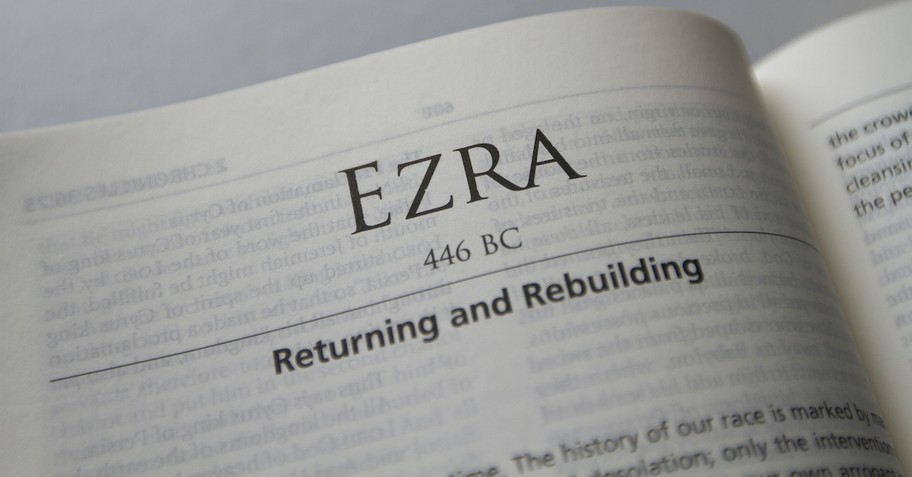4 Important Things We Can Learn Ezra and His Book in the Bible

The book of Ezra, written in tandem with the book of Nehemiah, chronicles the rebuilding of Jerusalem following the Israelite return from captivity in Babylon.
Though significant portions of Ezra and Nehemiah, originally written as one book in the Hebrew Bible, are devoted to the physical rebuilding of the Jewish temple and walls of Jerusalem, under Ezra’s leadership, the returning exiles would also experience a season of moral, social, and spiritual reformation as they recommitted themselves to the Word of God.
Photo Credit: ©Unsplash/Prisci

Who Was Ezra?
Ezra was the second of three key leaders to lead a remnant of Jewish exiles back to Jerusalem as prophesied by the prophet Jeremiah. This return happened in three stages.
With support from the Persian king Cyrus, and under royal edict, Zerubbabel led the first return to Jerusalem in 536 B.C. and was instrumental in helping rebuild the temple in Jerusalem.
Sixty years after the temple was completed, Ezra was commissioned by Cyrus’s successor, Artaxerxes, to lead the second Jewish return to Jerusalem in 457 B.C., focusing his efforts on rebuilding the community and returning the hearts of the people back to the Word of God.
Nehemiah, a cupbearer and trusted advisor to Artaxerxes I, led the third return in 444 B.C. and was responsible for rebuilding Jerusalem’s walls and outer defenses.
A gifted scribe, teacher, and descendent of Aaron through Eleazar, Ezra had found favor in the Persian courts during the reign of Artaxerxes, so much so that the Persian king commissioned him specifically to lead the second Jewish return to Jerusalem around 458 B.C. The caravan would set out the following year.
Given opposition faced by Zerubbabel and the first wave of exiles in rebuilding the temple (Ezra 4), King Artaxerxes would send Ezra, years later, with a royal letter giving him both civil and religious authority to continue the work the first wave had begun. In his decree, Artaxerxes also added provisions for the exiles to refurbish the temple with treasure taken during the Babylonian invasion (Ezra 7:11-26).
During his time in exile, Ezra had received extensive training in the Books of the Law (Genesis, Exodus, Leviticus, Numbers, and Deuteronomy) and had spent a significant amount of time in the Word of God as it was his job to copy, interpret, and transmit the Book of the Law to the people. Ezra loved God’s Word. As it is written, “he had set his heart to study the law of the Lord and to practice it, and to teach His statutes and ordinances in Israel” (Ezra 7:10).
In fact, during his time in Persia, Ezra had been instrumental in helping modernize the language of the Torah, correcting irregularities, updating and standardizing common expressions and preserving the integrity of Israel’s sacred text.
It was Ezra’s extensive training, attention to detail, commitment to God’s standard of holiness, and passion for the Word of God that would prove instrumental in helping lead the hearts of the people back to God through the absolute, eternal truth found in His Word.
As a leader, Ezra was passionate, purposeful, and direct. He confronted problems in the community with boldness, listened to the wisdom and encouragement of contemporary prophets, and always looked to the Word of God for guidance, encouraging the people to focus their attention on God’s plan, God’s Word, and God’s authority, never his leadership.
Photo Credit: ©Sparrowstock

What Does the Book of Ezra Talk About?
Ezra and Nehemiah is the direct sequel to the book of Chronicles and traces the history of the children of Israel from exile back to Jerusalem. Chronologically, though Ezra and Nehemiah are situated in the first third of the Bible, the events described in these books wrap up the history of the Old Testament, setting the stage for the arrival of Jesus Christ, the Messiah, in the New Testament roughly four hundred years later.
At the time of Ezra’s return to the Jerusalem, the children of Israel had been living in exile for almost fifty years. The prophet Habakkuk had warned that God would soon use captivity from a foreign power (Babylon) to chastise His people for their apostasy and idolatry.
Using King Nebuchadnezzar of Babylon as His rod of discipline, God’s judgment would come to pass in the years to follow.
In 605 B.C. Nebuchadnezzar overcame King Jehoiakim of Judah and carried off several key Jewish hostages, including a young Daniel and his friends, to Babylon.
In 597 B.C. Nebuchadnezzar suppressed a failed Jewish rebellion, carrying off an additional ten thousand hostages, which included King Jehoiachim and the prophet Ezekiel.
In 586 B.C. Nebuchadnezzar would destroy Jerusalem and the temple outright, with the remaining survivors being taken to Babylon. These devastating events are described in poetic detail by the prophet Jeremiah in the book of Lamentations.
However, even in Israel’s darkest hour, all hope would not be lost. Jeremiah had prophesied that God would use Israel’s time in exile to break them of their idolatry and return their hearts to back to their God and first love. Furthermore, in time, God would gather His people back to Jerusalem and there establish a new, everlasting covenant through His promised Messiah (Jeremiah 32:36-44; 33).
True to His word and the prophetic vision of shifting empires found in Daniel chapter 2, the Persian Empire, under Cyrus the Great, would conquer Babylon in 539 B.C. In 538 B.C., Cyrus, stirred by the spirit of the Lord, would grant permission for the Jewish exiles to begin their return to their ancestral home (Ezra 1:1-4).
The first return to Jerusalem, in which the temple of the Lord was rebuilt and dedicated (536 – 516 B.C.), is described in the first six chapters of Ezra.
Work on the temple would begin in 536 B.C. (Ezra 3) but stop in 534 B.C. (Ezra 4) due to political opposition from the neighboring Samaritans and Jewish interest in their own building projects.
At this time, God would send the prophets Zechariah and Haggai (Ezra 5) to encourage the exiles to get back to work on the temple. After a fourteen-year hiatus, work would resume, and the temple would eventually be completed and dedicated in 516 B.C. (Ezra 6).
To put things in context, the events of Esther, Queen of Persia (483 – 473 B.C.), occur between the first return (under Zerubbabel in 536 B.C.) and second return (under Ezra in 457 B.C.).
Ezra, the scribe, would arrive in Jerusalem with the second wave of exiles in 457 B.C. (Ezra 7).
Upon returning, however, Ezra noticed that the remnant of Israel had failed to keep the Law of Moses by intermarrying with non-exiles and Canaanite women (Ezra 9). Remembering how pagan religion and false worship had infiltrated the nation via mixed marriages, Ezra sought to avoid future calamity and reverse this trend by separating the Israelites from the practices of their neighbors (Ezra 9:12-15; 10:11).
As it was written, “for you are a holy people to the Lord your God; the Lord your God has chosen you to be a people for His personal possession out of all the peoples who are on the face of the earth” (Deuteronomy 7:6).
God had called Israel to be holy and set apart from their neighbors and other nations of the earth. If Israel obeyed God’s commands and kept to His good and perfect Law, they would live well and enjoy the benefits of His favor. If they disobeyed and walked in their own ways, they would stumble, stagnate, and suffer.
As student of the Word, Ezra understood this and stood before the people to lead them back to the principles found in the Law of Moses.
Later in Nehemiah 8-12, Ezra and Nehemiah would even come together to enact a seven-day Torah reading, knowing that the physical restoration of the Temple and city walls would not matter if social reform, moral revival, and spiritual renewal was not achieved. Here, Ezra focused his attention (Ezra 7-10).
Photo Credit: ©GettyImages/typhoonski

What Are Important Things to Know and Learn from the Book of Ezra?
1. No Experience is Ever Wasted
Even in exile, Ezra was being equipped and prepared for the days ahead. As he studied the Torah, poured over the Books of the Law, and meditated on the Word of God, his heart was being transformed, his focus sharpened, and his mind aligned to the things of God. This experience would prove invaluable in leading the hearts of the people back to God’s standard of holiness. As the apostle Paul would later spend years studying the Torah after his conversion on the Road to Damascus, so Ezra used his time in captivity to grow in the knowledge of God.
No experience is ever wasted for those who seek the Lord and have been called according to His purpose.
Nothing was ever easy for the children of Israel in exile. It was a less than ideal season of restricted freedom, where God’s people were forced to live under the authoritarian rule of those who hated them. They had no temple to worship in, no altar to sacrifice upon, and nothing to call their own. This was not their home. However, God had not abandoned His people. His plan for them, as Jeremiah had prophesied, was good and bigger than their worst days (Jeremiah 29:11). In fact, it included time in exile as a tool to realign their priorities and reform their hearts.
2. God’s Word is at the Center of All Revival
Upon returning to Jerusalem, both Ezra and Nehemiah understood that true revival was needed at a spiritual and social level to rebuild the community and return the hearts of the people back to God. It was good to be home, but if God did not have a home amongst His people, all their work would be in vain.
True revelation and revival would come through exposure to the Word of God. This is why Ezra and Nehemiah focused their attention on communal confession, reading, teaching, and instruction. As the Psalmist writes, “I will never forget Your precepts, for by them You have revived me” (Psalms 119:93).
Ezra’s knowledge of history and understanding of the Word of God led him to the truth: that as Israel held to the precepts of the Law, their path was secure. It’s when they abandoned God’s Word that calamity overtook them. God’s Word, therefore, would be at the center of spiritual revival.
3. God Moves in the Hearts of Kings and Authorities
It might seem strange to think that God would use foreign kings like Nebuchadnezzar, Cyrus, and Artaxerxes to achieve His goals, but that is exactly what He did. As the apostle Paul would later write, “for there is no authority except from God, and those which exist are established by God” (Romans 13:1).
Through the acts of Nebuchadnezzar and edicts of Cyrus and Artaxerxes, we see that God’s promises are not only true, His plans are always bigger than kings and earthly authorities, who come and go and whose empires rise and fall. Though wicked kings and foolish leaders stand against God, God’s spirit often moves in the hearts and minds of powerful rulers to accomplish His good and perfect plan, for He alone is sovereign!
4. All Roads Lead to the Cross
Though Ezra and Nehemiah were only moderately successful in ushering in a season of spiritual and social reform, the events following the return from exile would expose the true missing piece to Israel’s revival, transformation of the heart.
To many, the book of Ezra and Nehemiah end on a low note and point of disappointment. The building may have been complete, but the revival was not. More was needed. Thus, as Old Testament concludes, the physical restoration of Jerusalem paved the way for the spiritual restoration of all mankind through the arrival of the prophesied Messiah, Jesus Christ, in whom a new covenant would be made and true salvation would be found.
Photo Credit: ©Unsplash/Naassom Azevedo
Originally published September 21, 2021.









